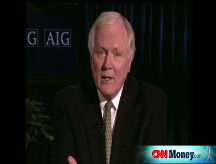Low credit costs, but crunch still here
The cost of borrowing has fallen significantly from the height of the crisis, but AIG and American Express show the problem is still alive and kicking.
NEW YORK (CNNMoney.com) -- Lending rates remained around historic lows Tuesday, but don't stick a fork in the credit crunch just yet.
The 3-month Libor rate dropped to 2.18% from 2.24% on Monday, according to Dow Jones, marking the rate's lowest point since Oct. 29, 2004. The overnight Libor rate rose to 0.35% from an all-time low of 0.32%, according to Bloomberg.com.
During the height of the credit crisis last month, 3-month Libor was at 4.82%, and the overnight rate was at an all-time high of 6.88%. Lower rates can boost the strangled credit markets because more than $350 trillion in assets are tied to Libor.
Libor, the London Interbank Offered Rate, is a daily average of what 16 different banks charge other banks to lend dollars in the U.K. and is a key barometer of liquidity in the credit market.
The government has initiated a multitude of programs aimed at easing the stranglehold on credit and encouraging private lending, many of which have helped drive down lending rates. But just because borrowing is cheaper doesn't mean there are a lot of buyers out there.
With anxiety still widespread amid a likely economic recession, two huge corporations demonstrated Monday how the credit crunch is far from over.
Embattled insurance giant AIG (AIG, Fortune 500) announced that it restructured its bailout deal with the Federal Reserve and Treasury Department, giving the company more breathing room to spin off subsidiaries and pay back its $60 billion federal bridge loan. As part of the new package, the expiration on AIG's loan was lengthened to five years from two, as the current credit environment has proven a difficult time to sell off businesses.
Also Monday, AIG reported a loss of $24.5 billion, its biggest quarterly loss ever. CEO Edward Liddy attributed the poor results to "extreme dislocations and volatility in the capital markets" during the three months ended Sept. 8 - a week before the credit crisis gripped Wall Street.
Specialty finance company American Express (AXP, Fortune 500) has also struggled through the credit crunch. Late Monday, the Fed granted "bank holding company" status to AmEx so that the company can gain access to the Fed's emergency lending window to ease its liquidity concerns.
As companies continue to struggle to acquire private financing, they will rely on the government to provide them with the funding they need to stay afloat.
Market gauges: Though credit remains tight, two key gauges of risk sentiment indicated that confidence is returning.
The Libor-OIS spread fell to 1.69 percentage points from 1.8 points on Monday. The spread measures the difference between actual borrowing costs and the expected official borrowing rate from the Fed. It is used as a gauge to determine how much cash is available for lending between banks. The bigger the spread, the less cash is available for lending.
Former Fed chairman Alan Greenspan has said that the Libor-OIS spread will serve as a good gauge for when credit has returned to normal. Though the indicator has fallen from a high of 3.66 points set last month, it is still far above the 0.11 percentage point seen prior to Sept. 15.
Another indicator, the "TED spread," fell to 1.96 percentage points from 2.03 points, falling below 2 points for the first time since the financial crisis gripped Wall Street.
The TED spread measures the difference between the 3-month Libor and the 3-month Treasury bill, and is a key indicator of risk. The higher the spread, the less willing investors are to take risks.
The U.S. Treasury market was closed Tuesday for the Veterans Day holiday. ![]()


